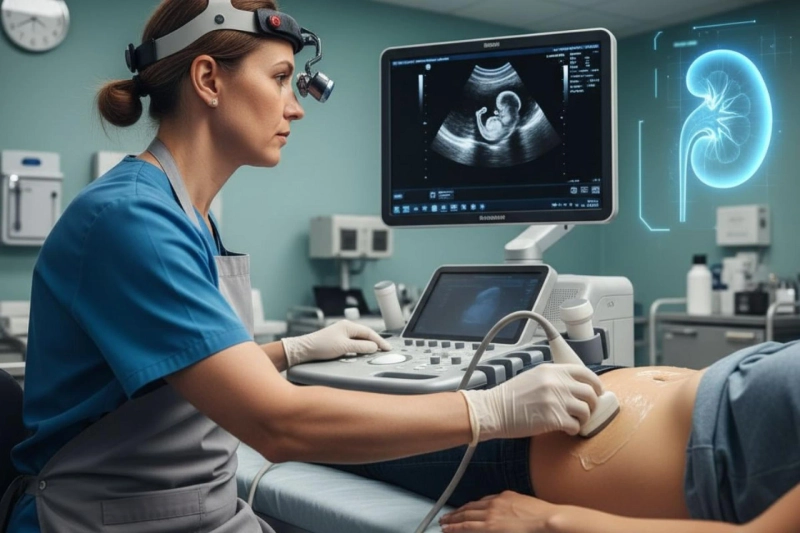Radiologists perform a very crucial job to identify abnormalities through imaging techniques. Diagnosing diseases and injuries through test reports falls under their domain, and they execute it pretty efficiently. Their main challenge is preparing clean radiology bills and claims. If you are running an imaging test center, this guide will help you improve your revenue cycle with a decent cash flow.
If you've ever had a claim for a renal ultrasound bounce back with a denial, you already know how frustrating billing can be. On the clinical side, the exam is straightforward. You need to look at the kidneys, sometimes the bladder, and document what you see. But once it lands on the billing desk, that's where the headaches begin.
Renal ultrasound billing is under more scrutiny than ever this year. Both Medicare and commercial carriers have doubled down on claim reviews, and small slip-ups (Like the wrong CPT code or a missing modifier) are costing practices thousands of dollars each year. What's worse, most of these errors are completely preventable with a bit more attention.
Here are the five areas where imaging practices most often go wrong and how you can avoid falling into those traps.
Why Renal Ultrasound Billing Matters in 2025
Renal ultrasound is one of those bread-and-butter studies. Nephrologists, urologists, and primary care doctors order it constantly. It is effective in detecting kidney stones, chronic kidney disease, unexplained hematuria, and other conditions. Because of that high volume, payers view it as a potentially over-utilized service. As a result, they watch these claims closely to ensure accuracy.
This is why imaging centers' billing accuracy matters. A denied claim doesn't just delay payment. Rather, it increases administrative costs and raises your audit risk. Getting it right the first time means protecting your revenue cycle and your compliance profile.
Clinical vs. Billing View of a Renal Ultrasound
From a clinical perspective, you might think your main priority is accurate detection of kidney-related diseases. However, radiology billing doesn't work that way. Insurance payers want to know exactly what was done. They want details like - which body parts were imaged, and why the exam was medically necessary.
That means your documentation and coding have to match the clinical work performed. A "limited" ultrasound of one kidney coded as a "complete" study will raise red flags and eventually denials.
CPT Codes: The Foundation of Correct Radiology Billing
This is where most errors start. There are two main CPT codes for renal ultrasounds. Radiology billing staff should know when to use these particular codes is critical:
- 76770 – This CPT code describes a complete diagnostic retroperitoneal ultrasound (For both kidneys and the bladder)
- 76775 – This code is used for a limited, real-time, retroperitoneal ultrasound (For one kidney or follow-up exam)
Here's where most in-house imaging centers' billing services go wrong: billing 76770 when the bladder wasn't actually imaged. If your documentation doesn't specifically note that the bladder was included, that claim is vulnerable. Payers will ask for the detailed report, and if the bladder isn't there, they'll deny or claw back payment.
On the other side some providers under-code unwontedly due to a lack of proper and up-to-date knowledge. They use 76775 even when they've performed a full bilateral study plus bladder. That leaves money on the table.
To ensure optimum accuracy in renal ultrasound billing, you need to provide all-inclusive documentation. Sonographers and billing staff should make sure to interpret the physicians' documents that were imaged every single time.
Modifiers: Small Codes, Big Impact
Modifiers are one of the most common sources of mistakes, yet they're critical to getting paid correctly. The main ones you'll use with renal ultrasounds are:
- 26 – Professional component only (just the physician interpretation).
- TC – Technical component only (equipment and technologist costs).
- RT/LT – When you need to specify the right or left kidney.
Here's an example for ease of understanding: An imaging center performs the scan, and the radiologist interprets it from home. If you don't split the claim with 26 and TC, the payer may only reimburse one side, leaving either the radiologist or the facility unpaid.
Some carriers are picky about laterality. For a limited study, they may want to see RT or LT modifiers. If you leave that out, your claim could get stuck in limbo.
ICD-10: Supporting Medical Necessity
Even with perfect CPT coding, your claim won't stand without the right diagnosis code. The diagnosis is what justifies why the ultrasound was needed. Commonly accepted ICD-10 codes for renal conditions include:
- N18.9 – Chronic kidney disease, unspecified
- R31.9 – Hematuria, unspecified
- N20.0 – Kidney stone
- R80.9 – Proteinuria, unspecified
Where many imaging practices stumble is in vague or unsupported documentation. Here, records should clearly describe the symptoms along with dialysis. Billing staff should precisely tie the mentioned ICD-10 codes that thoroughly establish medical necessity.
Documentation: Your Audit Insurance
Think of documentation as your shield. If a payer or auditor asks for proof, your report should spell out:
- The reason for the exam.
- Whether it was one kidney or both.
- If the bladder was included.
- Findings and interpretation.
Leaving out even one of these details puts your reimbursement at risk. For instance, if you bill 76770 but your report doesn't mention the bladder, you can bet an auditor will notice.
The 5 Most Common Billing Errors
After years of reviewing claims, here are the mistakes that pop up again and again:
- Confusing complete and limited codes (76770 vs. 76775).
- Forgetting modifiers like 26 or TC when splitting professional and technical components.
- Weak documentation that doesn't mention all structures imaged.
- ICD-10 mismatch—coding a service without a covered diagnosis.
- Bundling issues—triggering NCCI edits by combining codes incorrectly.
Fixing these errors usually comes down to staff training and better internal audits.
How Outsourced Radiology Billing Services Ensure Optimum Accuracy
As we have discussed above, radiology billing is pretty complex. On top of that, internal billing staff deal with a wide range of clinical responsibilities. Hence, they often commit silly mistakes in claims, which lead to payer denials. Eventually, that exposes the center to financial strain. Here, ultrasound billing outsourcing for radiology practices comes to offer the best affordable solution.
These third-party radiology billing companies offer the most affordable services with extreme accuracy. Many of them offer specialty-specific billing and end-to-end RCM services for only $7 per hour. Industry data shows that imaging centers can save up to 80% of their office expenses by outsourcing. Hence, if you want to streamline your billing for renal ultrasounds and other processes, connect with a reputable billing company. They will ensure optimum accuracy and enable you to enhance your overall clinical performance at the same time.


